The Museum Collections
Introduction
I. History and Art Collection
1. Icons of the 14th – 19th centuries
icons of the 14th – 17th century
2. Jewelry art of the 14th – 20th century
jewelry art of the 14th – 17th century
jewelry art of the 18th – 19th century
the european silver 14th - 19th centuries
3. Small-size sculptures (works of metal, wood, bone)
XI – the beginning of the XX century
Small-size sculptures 11th – 17th century
Small-size sculptures 18th – early 20th century
enamel of Troitza masters 15-8th – early 20th century
5.Embroidery, lace, textiles of the 14th - early 20th century
icon and ornamental embroidery
gold and silver lace
6.Painting of the 18th – 21st centuries
painting of the 18th – 19th centuris
painting of the 20th – 21st centuris
II.Manuscripts and old printed books of the 14th – 17th century
IV.Lithography of the 18th – 19th century
V.Numismatics
VI.Medals of the 18th - early 20th century
VIII.Archeology collection
IX. Russian folk and applied and decorative art of the 17th – 21st c.
1. Artistic wood
folk carved and painted wood
wooden toys
house carving of Sergiev Posad
Khokhloma and Gorodets painting
2. Artistic textiles
embroidery and weaving
printed textiles and lace
Russian shawls
folk costumes
folk garments
printed cotton kerchiefs
|
Embroidery and weaving of the 18th – 20th century (p. 1) |
In a museum is the richest collection of subjects of weaving and embroideries of the 18th-20th century, presented by samples of almost all areas of northern and average European part of Russia. Woven and embroidered patterns decorate clothes, headdresses, household goods: towels, cloths, edgings, scarfs, shawls etc. High art of weaving and an embroidery were brightly reflected in creation female (the man's ones has not remained almost) celebratory and wedding suits, belts and female headdresses.
In a decor of suits, towels, cloths, edgings had the important place pattern weaving and weaving with a pick-up stick (“taken” weaving), and also embroidery. The masterly techniques of execution mark out pattern weaving. The weaving of Voronezh executed by the most simple techniques of an interlacing is rich and various. Voronezh homespun woollen skirt inimitable in its courageous combination large woven cages with a multi-colour embroidery. The pattern weaving of Ryazan differs of masterly techniques of execution. Its techniques is such that the pattern on one and other side come out identical and it seems as cut in that gives it clearness. The basic colour combination of pattern weaving - white with red.
The “taken” weaving techniques was but more widespread in Russian. At creation “taken” pattern a thread took, considered. From this operation the weaving has the name - “taken”. The dense, close, relief pattern of red colour on aprons, head scarves, shirts and towels underlines a canvas whiteness. But the colouring is especially bright, rhythmic and brilliant technical skill were showed in manufacturing of pattern woolen belts. Cheerful on colour, they amaze with a variety of patterns and beauty of a rich, sonorous palette.
|

Towel. The end of 19th - the beginning of 20th century. Tula region |

Belts. The beginning of 19th century. Arkhangelsk and Vologda region |

Belts. The beginning of 20th century. Arkhangelsk and Vologda region |
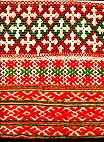
The end of towel. 1894. Rzhev |
The unique collection of embroidery in the Sergiev-Posad museum represents huge art and a historical value. It testifies to amazing riches of the ornamental heritage which have kept deeply traditional and originally national archaic lines. In a weaving and embroidery twiddle as well as in a carving and painting on a wood strongly keep motives, that took the roots in far pagan times, - circles, rhombuses, crosses, images of sacred deer, goose, duck; images of a female figure - goddesses of the earth and fertility - and life trees in an environment of sacred animals were one of widespread.
Ancient motives have found almost in each of regions of Russia. Embroideries of Tula and Kaluga, executed by techniques « interweave», are very decorative and sated on colour. The towel with fantastic leopards looks surprisingly elegantly. Images of leopards are not casual on embroideries of the Yaroslavl, Kostroma, Novgorod lands - with a course of centuries, new motives joined into ornamental of Russian national embroidery under the influence of culture of Russian cities. Embroideries of Smolensk region sunny and radiant on colour. The neighborhood of red and yellow colours gives softness to embroidery. The techniques of a stitch is called here as sewing on a cut.
|
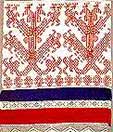
Embroidered pattern with leopards. Towel. 19th century. Tula region (technics « interweave») |
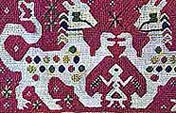
Podzor. 19th century. North region. Flax. Stitch |
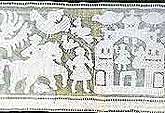
The end of towel. Second half of 19th century. Torzhok |
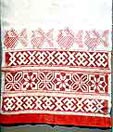
Wedding towel. Fragment. Second half of 19th century. Tver |
|


